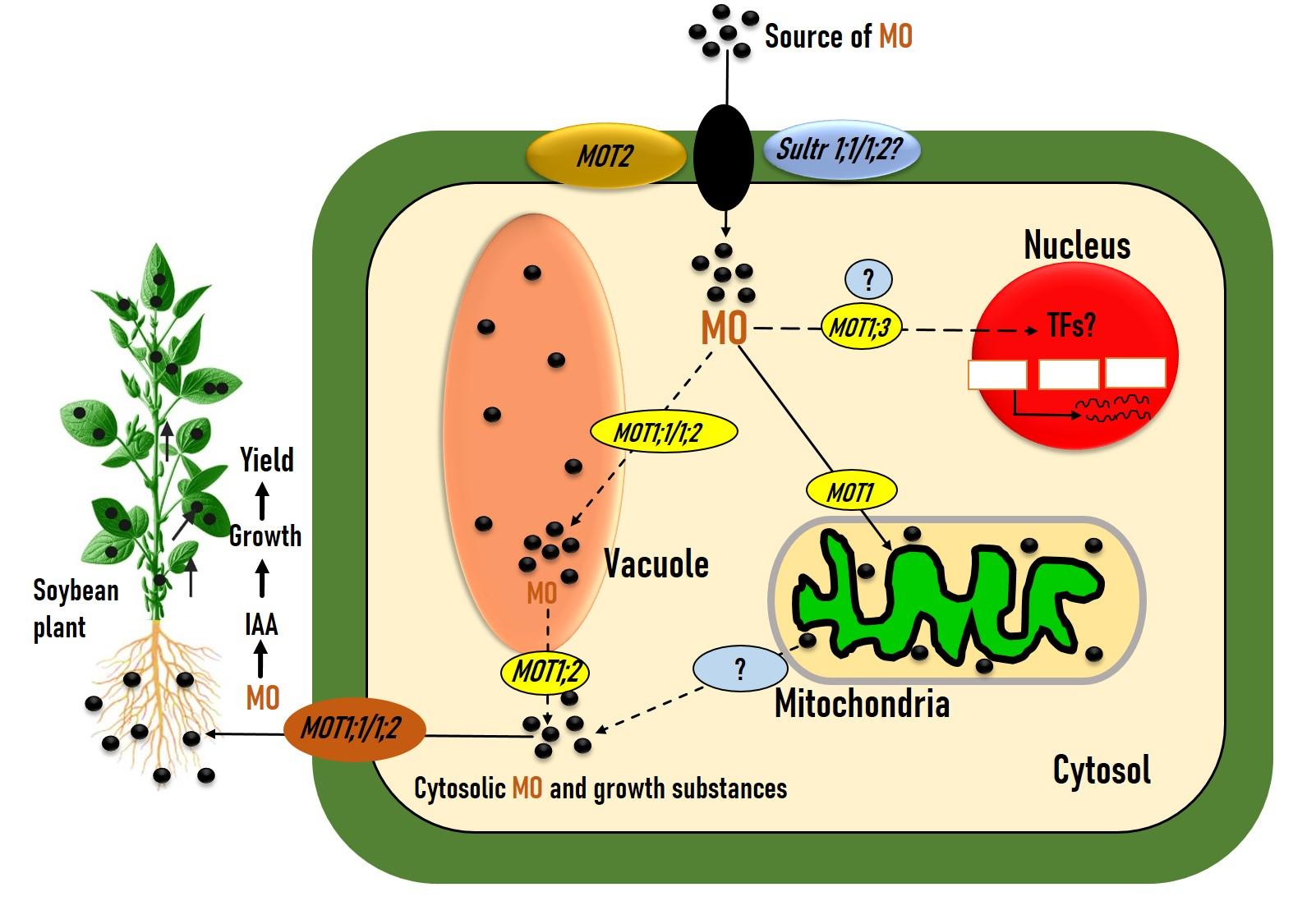Dual benefits: MOT1;1/1;2 coordinates both crop growth and productivity
Abstract
Molybdenum (Mo) fertilization is crucial for grain fitness and yields. However, transition metal-dependent hormone delivery system is largely unknown in soybean legume. Recently, Zhang et al discovered the Mo-transporter genes MOT1;1 and MOT1;2 through a genome-wide association study (GWAS). The transporter genes orchestrate plant growth and plant productivity in soybean by facilitating Mo-dependent auxin synthesis.
INTRODUCTION
Plant growth and yield are key traits coordinate total agricultural production to global food security. The major grain crop is grown around 1% that is lower than the growth rate of world population [1]. Therefore, food security of the global population seems to be under threat. In this scenario, increasing food crops growth and productivity through ecofriendly approaches should be major focused for sustainable agriculture. Mineral boosting in grain along with crop improvement is an effective strategy, where molybdenum (Mo) serves as the active center of nitrogenase enzyme and possesses immense potential for auxin synthesis that led to improve plant growth and productivity [2]. The Mo-concentration is driven by MOT1;1 and MOT1;2 transporters that enhance auxins, growth, and yield traits in plants [2, 3]. Various studies have explored the function of molybdate transporter specially MOT1;2 participate in interogans Mo translocation and remobilization in different rice cultivars [3, 4]. Zhang et al identified and characterized key Mo-transporters MOT1;1 and MOT1;2 in soybean that driven Mo-uptake and translocation, while MOT1;3 is not fully active in Mo-transport activity [2]. The MOT1;1 and MOT1;2 transporters driving enhancement of Mo-concentration lead to improving yield traits by regulating auxin (Indole 3-acetic acid) synthesis under acidic to moderate acidic soils.
INVOLVEMENT OF MOT1;1/1;2 IN MOLYBDATE UPTAKE AND MOBILIZATION
The MOT1;1 and MOT1;2 are crucial Mo transporters involved in Mo uptake and transportation in plants. It has already been reported the function of MOT1;1 coordinates interogans Mo distribution in several rice genotypes [3, 4]. A rice mutant harboring a complete deletion of MOT1;2 showed lower grain Mo concentration compared to WT . In contrast, the concentration of Mo in grains was restored through induction of WT MOT1;2 [4]. These findings were consistent with the recent breakthrough in soybean plant by Zhang et al., where in mot1;1/1;2 double mutant MOT1;1 and MOT1;2 functionally redundant and root derived the decline of Mo concentration in shoots and seeds. Based on these above insights a key model figure was drawn (Figure 1). However, the MOT1;1 and MOT1;2 overexpression lines increased the Mo accumulation in leaves and seeds that also validated the Mo-transport ability which found in double mutant soybean lines (Figure 1). This observation is very consistent with recent finding where the expression of MOT1;2 was upregulated in flag leaf and the second leaf during the grain filling stage, and MOT1;2-GFP protein localized to the vacuolar membrane when it found to be expressed in tonoplast [3]. Furthermore, the overexpression of MOT1;2 enhanced mobilization of Mo from seedling roots to shoots. The result suggests that MOT1;2 or MOT1;2 may active as vacuolar Mo exporter mediating the efflux of Mo from vacuole into cytoplasm, subsequently translocated into shoots, grains and aerial parts (Figure 1).

CROSSTALK AMONG MOT1;1/1;2, CROP YIELD, AND GROWTH REGULATION
The MOT1;1/1;2 controls yield related traits by regulating Mo-dependent indole-3-acetic acid (IAA) synthesis [2]. The MOT1;1/1;2 is a causal candidate that changes both transcription and protein activity, contributed to regulating Mo-concentration uptake and long-distance transport, which led to enhance yield in plants. Interestingly, MOT1;1 and MOT1;2 also coordinated growth enhancement by regulating increased indole-3-acetic acid (IAA) synthesis rather than associated with nitrogen assimilation or symbiotic nitrogen fixation (SNF) [2]. Soil pH is another factor that influence crop yield, amendment-based enhancement of soil pH level assists to crop yield up to 13-36 % [5]. In contrast, Zhang et al. noticed MOT1;1/1;2 was active in improving yield traits in soybean while the plants were cultivated at acidic to moderate acidic soils [2]. The MOT1;1 and MOT1;2 genes enhanced plant growth by regulating indole-3-acetaldehyde (IAAld) aldehyde oxidase (AO)-mediating IAA synthesis. Additionally, Mo-concentration may vary in different plant organs due to activation of MOT1;1 and MOT1;2 [2]. These above findings suggest Mo-uptake, transportation, plant growth and yield regulated by MOT1;1/1;2 where natural variant also a factor.
CONCLUDING REMARKS AND FURTHER DIRECTION
It is generally known that plant growth and yield is regulated by several plant growth regulators, bio-stimulants, multiple environmental factors. How such types of growth and yield traits regulated by mineral transporters genes is an interesting area in grain crops that needs attention. However, molecular mechanisms underlying mineral transporters involving growth, yield, nutrient enrichment in grains remains largely unknown. The findings by Zhang et al. disclosed a new direction of trace element-transports derived regulation of plant growth and yield traits in plants [2]. This study further connects the understanding of functional mechanisms towards foliar application of Mo fertilizer and Mo-nanofertilizer based boosting nutrient and yield enhancement in grain crop species. Finally, it would be useful and fascinating to the grain crop breeders and farmers for grain crop improvement through breeding programs.
ACKNOWLEDGMENT
None.
AUTHOR CONTRIBUTIONS
The two authors contributed equally to this work.
CONFLICT OF INTERESTS
The authors declare no conflict of interests.
References
- [1]Hemathilake DMKS, Gunathilake DMCC. Agricultural productivity and food supply to meet increased demands. In: Bhat R, editor. Future Foods: Academic Press; 2022. p. 539-53.
- [2]Zhang J, Liu S, et al. Natural variants of molybdate transporters contribute to yield traits of soybean by affecting auxin synthesis. Current Biol. 2023;33:5355-67.e5.
- [3]Hu D, Li M, et al. The vacuolar molybdate transporter OsMOT1;2 controls molybdenum remobilization in rice. Front Plant Sci. 2022;13:863816.
- [4]Ishikawa S, Hayashi S, et al. Tonoplast-localized OsMOT1;2 participates in interorgan molybdate distribution in rice. Plant Cell Physiol. 2021;62:913-21.
- [5]Zhang S, Zhu Q, et al. Effects of soil amendments on soil acidity and crop yields in acidic soils: A world-wide meta-analysis. J Environ Manage. 2023;345:118531.